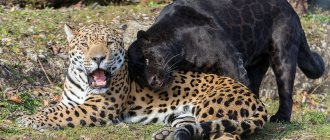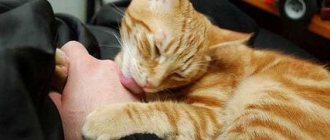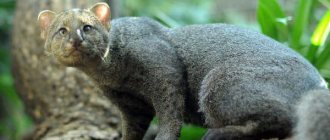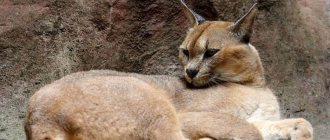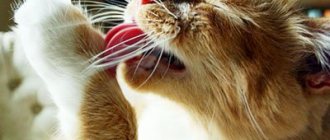Scientific classification
- Kingdom: Animalia (animals)
- Phylum: Chordata
- Class: Mammalia (mammals)
- Order: Carnivora (predatory)
- Family: Felidae (felines)
- Genus: Puma (cougars)
- Species: Puma yagouaroundi (jaguarundi)
Another scientific name for the genus "Herpailurus" comes from the Latin word "herpa" ("strange") and the Greek word "ilurus" ("cat"). The specific name "yagouaroundi" comes from the word "yagua", which refers to all carnivorous animals, and the ending "rundi", probably derived from the word "hung'i", meaning "brownish". “Strange brown cat” perfectly describes the jaguarundi.
Varieties
Scientists identify eight subspecies of jaguarundi:
- Puma yagouaroundi ameghini – Argentine province of San Luis;
- Puma yagouaroundi cacomitli - Mexican state of Tamaulipas and southern Texas;
- Puma yagouaroundi eyra - mainly Paraguay, certain areas of Brazil and Argentina;
- Puma yagouaroundi fossata – Mexican state of Yucatan and Honduras;
- Puma yagouaroundi melantho - Peruvian region of Huanuco and some states of Brazil;
- Puma yagouaroundi panamensis – Panamanian province of Chiriqui;
- Puma yagouaroundi tolteca – Mexican state of Sinaloa and American state of Arizona;
- Puma yagouaroundi yagouaroundi – Amazonian forests and Guyana.
Spread range
Geographical distribution
Photo: Wikipedia
The ancestors of the jaguarundi likely evolved in Eurasia and migrated to the Americas across the Bering Landscape about 16,000 years ago . These wild cats now have a wide geographic distribution, extending from southern Texas to the eastern and western lowlands of Mexico, through the inter-Andean valley of Peru, into southern Brazil and Paraguay, into the provinces of Buenos Aires and Rio Negro in Argentina. There have been several recorded sightings of the jaguarundi in Florida, and a small population here may have resulted from introduction (accidental or deliberate relocation) by humans.
- Biogeographic regions: ocarctic, neotropical
Habitat
These cats inhabit a wide range of open and closed habitats: from wet grasslands, plains near bodies of water, dry bushes and swampy savannas to virgin tropical forests. Access to dense ground cover and dense ground vegetation appears to determine habitat suitability for the jaguarundi. They prefer forest edges and secondary scrub, although this may simply be where they are most often found.
Photo: Happy Hootenanny
These cats are rarely found deep in forests, but often live in open lowlands near shelters. There have been reports of jaguarundis found at altitudes ranging from 2,000 to 3,200 meters above sea level.
- Habitat: temperate, tropical
- Terrestrial Biomes: Savannah, Wet Grassland, Chaparral, Coastal, Rainforest, Shrub
Home range
The personal territories of jaguarundis vary greatly between populations. A radiotelemetry study in Belize showed that the habitats of these cats are enormous . The territories of males and females vary significantly: 88-100 km² for adult males and 13-20 km² for adult females. Male ranges overlap by less than 5%. Both sexes periodically use different areas within their widely dispersed ranges, rather than regularly patrolling the boundaries.
In Brazil, jaguarundis have a very low density of 1-5 cats per 100 km², but in Mexico their population is estimated at 20 cats per 100 km². Increasing numbers of cats in the population result in smaller home ranges and more overlapping territories.
Photo: Miroslav Heran
Population density also depends on habitat. For example, in the Brazilian savannas, home ranges for females and males ranged from 18 to 40.2 km2, whereas in the forest-farmland mosaic they ranged from 1.4 to 34.9 km2. By comparison, a study conducted in the Mexican plains found that males' personal territories were 9.6 km2 and females' territories were 8.9 km2, with significant overlap between the sexes.
Character traits
Appearance
The Jaguarundi is considered a cat with relatively few feline traits . In appearance it resembles a Sumatran cat, but larger and without the dark lines on the cheeks.
Photo: Hedwig Vanhaevre
They differ from other smaller species of neotropical felines by their elongated body, small rounded ears, short thin limbs (relative to the length of the head and body) and uniform (at any age) polymorphic hair. Their head does not have rounded contours, it is slightly flattened and elongated. The eyes are small, close-set, light amber or honey brown in color. The tail is long and fluffy. A jaguarundi cannot completely remove the claws of its hind paws, just like a cheetah.
Coloring
Short and smooth fur of a uniform color throughout the body, sometimes the head, neck and ventral side have a lighter shade. The hair is typically light at the base and tip, giving some animals a gray-haired appearance. It is noteworthy that the jaguarundi is one of the few cat species in which the back of the ears does not have a contrasting color.
Photo: Eze Vivas
The coat can have three colors : blackish, brownish-gray and reddish-brown. Dark or gray fur is usually characteristic of inhabitants of damp, dense forests, while individuals from arid, open habitats have a reddish-brown coat. Black-haired jaguarundis are more associated with tropical forests. However, cats of all colors can be found in all habitats.
The blackish-brown jaguarundi is sometimes mistaken for a tayra. The latter, however, always has a distinct buffy-yellow or orange-yellow patch on the throat.
Previously, the red variety was considered a separate species, but today it is known for certain that cubs with different coat colors can be born in the same litter.
Dimensions
This is a medium sized animal. Of all the small neotropical cats, only ocelots are larger than jaguarundi. The length from the tip of the nose to the tip of the tail ranges from 84 to 137 cm, weight - from 3.5 to 9.1 kg. The tail makes up about two-thirds of the length of the head and body.
- Sexual dimorphism: male is larger
- Body length (without tail): 53-77 cm
- Tail length: 31-60cm
- Shoulder height: 25-35 cm
- Body weight: 3.5-9.1 kg
Captivity
These unique cats are found in all major zoos in the world and in captivity they reproduce well approximately twice a year. Jaguarundi also live in many national parks; they can be especially often found in the reserves of Brazil.
The first experience of domestication belonged to the local population - Indian tribes living on the territory of modern Panama. This happened a long time ago, before the capture of these territories by the Spaniards. Jaguarundi lived in Indian houses, hunting rats, mice, other rodents and pests. At the same time, no one could stop cats with wild blood from eating poultry. Therefore, as farming and poultry farming developed after the seizure of Latin American lands by Europeans, the practice of keeping Jaguarundi at home came to naught.
Although there was no mass extermination of Gato, since their red or gray fur was never popular. Jaguarundi suffered only from accidentally falling into traps and snares set for other animals and birds.
In addition, in some areas of American lands there has been a sharp change in biotopes as a result of human activity - deforestation and drainage of swamps, which has led to a reduction in natural cat populations.
Colonies of the subspecies P. y. ameghinoi in North and Central America are listed in the first appendix of the CITES Game Trade Convention; all other species are listed in the second appendix.
Lifestyle and behavior
This cat is difficult to trap due to its cowardice and secrecy, so little detailed information has been collected about the jaguarundi's temperament. It is known that they are predominantly terrestrial animals , although they can also move through trees with great agility and speed, especially when being pursued. These cats sometimes chase monkeys, jumping from branch to branch, while their long tail helps them balance. Jaguarundi are good jumpers. When catching birds, they can jump up to two meters high. Like the fishing cat, the jaguarundi is an excellent swimmer.
Photo: João Vitor Andriola
Unlike most wild cats, the jaguarundi is active during the day . He hunts mainly in the morning and evening. Activity peaks between 10:30 and 11:30 and 14:00 and 16:00, with very little activity after sunset. This behavior helps minimize competition with the ocelot, which is active at night. At night, jaguarundis rest in the trees.
These cats lead a solitary lifestyle , although they are able to tolerate the presence of other individuals of their species. They travel and collect food in pairs mainly during the breeding season.
What does it eat?
This animal is not averse to eating mammals, reptiles, birds, fish and frogs. Florida rabbits, spiny chinchillas, iguanas - all these animals are delicacies for the jaguarundi. Occasionally they feed on fruits and insects.
Jaguarundi, like all predators, prefers protein foods.
In search of food, the jaguarundi has many competitors, including a variety of cats, especially long-tailed cats and ocelots.
Communication and perception
Jaguarundi have good hearing , the upper limit of audibility is 100 kHz. These animals have a unique characteristic that is very unusual among cats: they use no less than thirteen different sounds to communicate, ranging from purrs to whistles and bird chirps. During reproductive receptivity, the female rolls over onto her back and makes a faint whine.
Jaguarundi is a territorial animal . It marks the boundaries of its home range in several ways: spraying urine, scraping wood and ground with its claws, wiping objects with its head and neck. If personal space is violated, the animal begins to loudly hiss and/or spit.
Photo: Animal Vogue
The tactile channel of perception is involved in communication between kittens, a mother and her offspring, as well as between sexually mature couples. The female screams loudly during mating, and the male gently bites her on the neck.
Purchasing a kitten
The Jaguarundi is very beautiful and there are many who want to have such an unusual pet at home. These wild animals are not bred in nurseries and it is not possible to purchase them legally.
There is information that Eira's kittens, poached in the wild, are smuggled to other countries and sold at prices ranging from 20-25 thousand dollars. This method is illegal, and many children die without going through the difficult journey.
Eating habits
These carnivores hunt primarily on the ground. Their diet typically consists of small rodents, birds, lizards, amphibians and reptiles, which are also hunted by coyotes, mountain lions, bobcats and foxes. Prey weighing more than 1 kg, such as rabbits, opossums and armadillos, are not unusual for feral cats. Jaguarundis also hunt poultry throughout much of their range. They sometimes feed on chinchillas, iguanas, guinea pigs, bristly rats, monkeys and fish.
Like other felids, the jaguarundi can consume small amounts of arthropod insects and vegetation (leaves and fruits). They were also seen eating a small deer, but this could have been carrion.
Photo: ZooChat
The average weight of vertebrate prey per day is 400 grams. In captivity, the average daily food intake of meat (dead and live chickens) is about 400-450 grams.
Natural enemies of the jaguarundi
Photo: What a jaguarundi looks like
Jaguarundi grows in small sizes, so the cat has plenty of enemies in wild natural conditions.
The predator's ill-wishers include:
- cougars;
- coyotes;
- ocelots;
- other close relatives of pumas.
It is not for nothing that the jaguarundi leads a secretive and inconspicuous life; the cat is very careful and suspicious. She will never be the first to attack a larger enemy, but would rather sit out in dense growth or leave the path on which she senses the presence of a strong enemy. If a fight is inevitable, then the jaguarundi will show all its courage and fearlessness; the battle is usually bloody and, unfortunately, the jaguarundi is often defeated, because the strength of the opponents is not equal. The ability to hunt during the day is very helpful for the jaguarundi, because at this time almost all other predators are sleeping.
Interesting fact: Jaguarundi have always been considered solitary animals, but recent studies have shown that they live in pairs or even small groups in some areas.
People who destroy animals, often invading their farm plots, can also be considered feline enemies. Local farmers simply cannot stand the jaguarundis that raid their fields and farmsteads. Man is displacing the jaguarundi from its habitable places, conducting his tireless economic activity, which also negatively affects the life of the predator, which is forced to look for new areas to live.
Reproduction
Breeding season
The reproductive season lasts throughout the year with peaks in different months, depending on the area. In the northern part of their range, the breeding season is late autumn (November-December). Estrus lasts 3-5 days, during which time females emit a scent that attracts males. The estrous cycle lasts 54 days.
Pregnancy lasts 63-75 days. Females have three pairs of nipples. Litter sizes range from one to four kittens, with the average litter size being 2 pups. Females give birth to about nine kittens over their lifetime. Dens are made in dense thickets, fallen logs, a cave or a hollow tree.
- Mating system: polygamy
- Breeding interval: once or twice a year
- Gestation period: 9-10.5 weeks
Cubs development
Photo: Brněnská Drbna
Newborns are deaf and blind, like all other kittens. They have spots on their bellies that disappear as they grow older. At about 6 weeks of age they begin to eat solid food, but the first attempts are made at about 3 weeks. The offspring leave the den after 28 days. Sexual maturity is reached at approximately 24-36 months. Life expectancy in captivity is up to 10-15 years.
- Range of number of offspring: 1-4 cubs
- Weaning range: 21 to 30 days
- Age of sexual or reproductive maturity: 2 to 3 years
Save Status
Jaguarundi fur has no commercial value , so the animals are not hunted for their pelts. But these cats are easily tamed and become good pets, so catching jaguarundi kittens is quite a profitable business for poachers. However, their captive breeding still leaves much to be desired.
These animals have the lowest conservation priority and are therefore not listed on the IUCN Red List.
Because little is known about the jaguarundi, its status must be periodically reviewed. There is an urgent need for further research into its demography and habitat to identify threats and their consequences, and to enable adequate conservation measures to be taken. But it is already obvious that the intensive transformation of savannas into industrial agricultural landscapes will negatively affect the jaguarundi population, but it is not yet clear how much.
Although the actual population size is unknown, hunting of jaguarundi is already prohibited in Argentina, Belize, Bolivia, Colombia, Costa Rica, French Guiana, Guatemala, Honduras, Mexico, Panama, Paraguay, Suriname, Uruguay, United States and Venezuela. In Peru, hunting is regulated. But in Brazil, Ecuador, El Salvador, Guyana or Nicaragua, these wild cats are not protected by law.
Price
The price of a Jaguarundi can reach $24,000. This breed is considered one of the most expensive wild felines in the world. In addition, the jaguarundi is very rarely found as a pet. In Latin America and many European countries, it is legally prohibited to sell cats of this breed. Finding ads and buying Jaguarundi is very difficult.
Jaguarundi kittens I. Jaguarundi kittens.
Considering the novelty and high cost of the breed, there are no reviews on our forum or website yet. If you have them, you can add a comment below.
